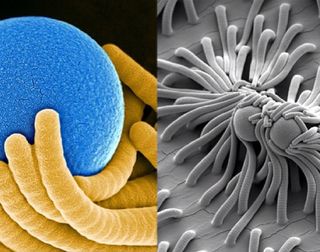
Do these look like real-life tentacles? Look again.
This seemingly bizarre beast is made of self-assembling nanofibers. Joanna Aizenberg and her laboratory are pioneers of self-assembling nanofibers that function as catch-and-release devices. Here, a scanning-electron microscope image of nanoscale bristles made of epoxy resin and immersed in a liquid. As the bristles dry, they can grab nearby particles, such as the sphere in this image, or a drug. They also store energy and can release the item. That's quite a few functions for something only about 1/1000th the width of a human hair.
The cool contraption is just one example of synthetic biology, a field that works with unnatural molecules and compounds to make tools familiar to natural biology.
ollow us @livescience, Facebook & Google+.
Sign up for the Live Science daily newsletter now
Get the world’s most fascinating discoveries delivered straight to your inbox.

